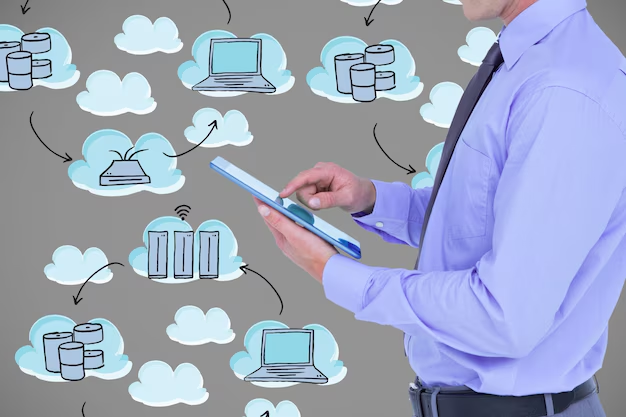Cloud computing has revolutionized the way businesses and individuals manage, store, and process data. With its flexibility, scalability, and cost-effectiveness, it is transforming industries and allowing organizations to innovate faster. In this article, we will explore the different cloud computing models and the advantages they offer.
1. What is Cloud Computing?
Cloud computing is the delivery of computing services—including servers, storage, databases, networking, software, and analytics—over the internet (the cloud). It provides on-demand access to resources without the need for physical hardware, allowing businesses and individuals to scale their IT infrastructure efficiently.
2. Cloud Computing Models

Cloud computing can be categorized into three primary models, each offering different levels of control, flexibility, and management. These models are:
Infrastructure as a Service (IaaS)
IaaS provides virtualized computing resources over the internet. It is the most basic level of cloud services and offers the infrastructure that organizations need to build their IT environments.
- Key Features:
- Virtual machines, storage, and networking.
- Scalability: Resources can be adjusted based on demand.
- Pay-per-use pricing model, reducing capital expenditures.
- Popular Providers: Amazon Web Services (AWS), Microsoft Azure, Google Cloud.
- Advantages:
- Cost Savings: No need to invest in physical hardware.
- Scalability: Resources can be easily scaled up or down.
- Flexibility: Businesses can install and manage their software applications and systems without being tied to a specific hardware configuration.
Platform as a Service (PaaS)
PaaS provides a platform allowing customers to develop, run, and manage applications without dealing with the infrastructure. It offers a ready-to-use environment that abstracts the complexities of hardware management.
- Key Features:
- Includes operating systems, databases, and development tools.
- Supports software deployment without worrying about underlying infrastructure.
- Integrated development environments (IDEs) for building applications.
- Popular Providers: Google App Engine, Microsoft Azure App Services, Heroku.
- Advantages:
- Faster Development: Developers can focus on building applications without managing the underlying infrastructure.
- Built-in Scalability: Applications can scale automatically based on usage.
- Reduced Operational Overhead: No need to maintain servers or software updates.
Software as a Service (SaaS)
SaaS delivers software applications over the internet on a subscription basis. It is the most common model, allowing users to access software through a web browser without installing anything locally.
- Key Features:
- Ready-to-use software applications that are hosted in the cloud.
- No need for users to manage infrastructure, software updates, or maintenance.
- Accessible via any device with an internet connection.
- Popular Providers: Google Workspace, Microsoft 365, Salesforce.
- Advantages:
- Convenience: Software is accessible from anywhere, on any device.
- Automatic Updates: SaaS providers handle updates and security patches.
- Cost Efficiency: Subscription-based pricing eliminates the need for large upfront investments in software licenses and infrastructure.
3. Deployment Models of Cloud Computing
Cloud computing can also be classified by deployment model, which determines where and how the cloud services are provided. The most common deployment models are:
Public Cloud
In a public cloud, the cloud infrastructure is owned and operated by a third-party cloud service provider. The services and resources are made available to the general public.
- Advantages:
- Cost-Effective: The shared nature of resources allows for lower costs.
- Scalability: Easily scalable to meet changing demand.
- Reliability: Public cloud providers have data centers around the world, ensuring high availability and redundancy.
Private Cloud
A private cloud is used exclusively by one organization. The cloud infrastructure can be located on-premises or hosted by a third-party provider. It offers more control and customization compared to public cloud solutions.
- Advantages:
- Security and Control: Greater control over data and security protocols.
- Customization: The infrastructure can be tailored to the specific needs of the organization.
- Compliance: Easier to meet industry-specific compliance standards and regulations.
Hybrid Cloud
A hybrid cloud combines both private and public cloud solutions, allowing data and applications to be shared between them. It offers the flexibility to move workloads between environments based on business needs.
- Advantages:
- Flexibility: Organizations can maintain sensitive data on a private cloud while utilizing public cloud resources for less sensitive workloads.
- Cost Efficiency: Critical workloads can be run in the private cloud, while less critical ones can be moved to the public cloud to save costs.
- Disaster Recovery: A hybrid cloud can ensure business continuity by allowing for redundancy and backup in the public cloud.
4. Key Advantages of Cloud Computing
Cloud computing offers several significant advantages that are driving its adoption across industries:
Scalability and Flexibility
Cloud computing allows businesses to scale their IT resources up or down based on demand. This flexibility ensures that businesses only pay for what they use, making cloud services a cost-effective option for growing companies.
Cost Savings
By using cloud services, businesses eliminate the need for purchasing, managing, and maintaining expensive hardware and software. This results in reduced capital expenditures and operational costs.
Disaster Recovery and Business Continuity
Cloud services ensure that critical data is backed up and can be quickly restored in case of hardware failure or natural disaster. Many cloud providers offer built-in disaster recovery solutions, ensuring business continuity with minimal downtime.
Collaboration and Accessibility
Cloud computing enables collaboration by allowing multiple users to access the same documents and applications in real time, regardless of their location. This is particularly beneficial for remote teams and businesses with multiple offices.
Security
Many cloud providers offer robust security features, including encryption, firewalls, and identity management tools, ensuring that data is secure both at rest and in transit. While security remains a concern for some, cloud providers are often more equipped to handle security than in-house IT departments.
Conclusion
Cloud computing models—such as IaaS, PaaS, and SaaS—offer various levels of service and benefits to meet the diverse needs of businesses. From reducing costs and improving scalability to enhancing collaboration and security, the advantages of cloud computing are clear. As businesses continue to embrace these models, the future of cloud computing looks bright, driving innovation and efficiency across industries.
FAQs
Q1: What is the difference between IaaS, PaaS, and SaaS?
A1: IaaS provides infrastructure, PaaS offers a platform for application development, and SaaS delivers ready-to-use software applications via the internet.
Q2: Can businesses switch between cloud models?
A2: Yes, businesses can switch between cloud models based on their evolving needs, such as moving from a private cloud to a public cloud or adopting a hybrid model.
Q3: What are the security benefits of cloud computing?
A3: Cloud computing offers advanced security features like encryption, multi-factor authentication, and automatic updates, which can protect data better than traditional on-site solutions.
Q4: How does cloud computing help with disaster recovery?
A4: Cloud computing provides backup and recovery options, allowing businesses to quickly restore data and systems after an outage, ensuring business continuity.
Q5: What are the costs associated with cloud computing?
A5: Cloud computing uses a pay-as-you-go model, where businesses pay only for the resources they use. Costs vary depending on the services, storage, and computing power required.


